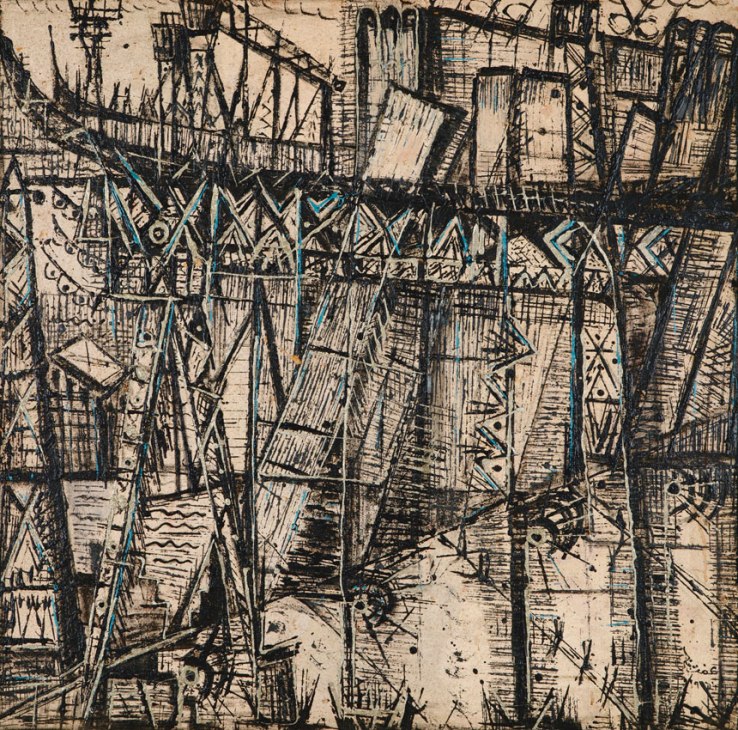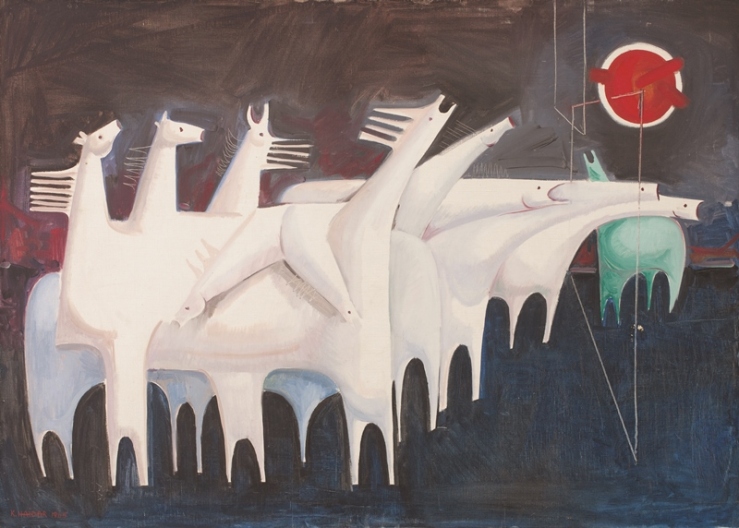
The construction of the Aswan Dam in the 1960s was, like seemingly everything in that era, a Cold War altercation between East and West. America and Britain refused to pay for the building of Aswan, which fans out into the blue Nile like the Art Deco proscenium arch of the Hollywood Bowl, its desert shades matching its parched surroundings. Nikita Khrushchev was willing to aide Egypt with the building costs though and the Soviet premier, performing some first rate Cold War posturing, appeared with President Nasser, cutting the red ribbon to open the first stage of construction with ceremonial aplomb.
Effat Nagy’s The High Dam is a depiction of the construction of Aswan and is featured in the first part of a showing of the Barjeel Art Foundation’s collection at the Whitechapel Gallery in London. The painting has a slight Soviet overtone, the scaffolding, which covers a steely industrial backdrop, bringing to mind the spiky edges of Kazimir Malevich. The initial impression is one of great might and muscle being employed in the name of an impressive undertaking, a symbol of the construction of a new Egypt, but look a little closer and the scaffolding appears frail, suggesting that this solidly built future may turn out to be flimsy.
Nagy and her husband Saad al-Khadem, were both pioneers of folk art in Egypt and she was invited by the Egyptian Ministry of Culture to visit the gargantuan construction site at Aswan. The poor labour conditions and the forced relocation of entire villages played on her mind and the minds of others who painted the scene. The poor conditions are echoed in Ragheb Ayad’s Aswan, which depicts skeleton figures doubled over in toil, working in a seemingly endless chasm.

The Barjeel Art Foundation is a United Arab Emirates-based initiative established to manage, preserve and exhibit the personal art collection of Sultan Sooud Al Qassemi. Thirty eight pieces of art will ultimately feature in the four part Whitechapel show, which will run in instalments into next year, charting the development of Middle Eastern art from Modern to Contemporary.
The seed that gives birth to this freewheeling collection is the Armenian artist Ervand Demirdjian’s Nubian Girl. Painted between 1900 and 1910, the canvas is beautiful and traditional, with the evident influence of Modern western and, in particular, Dutch and French portraiture. The painting bears a passing resemblance to Vermeer’s Girl with a Pearl Earring and is, perhaps, more mystical, her enchanting eyes seemingly outshining her jewels to become the brightest thing on the canvas.
Traditionalism is swept away when the exhibition considers art from another, more contemporary cause célèbre of western interference in the Middle East, Iraq. Kadhim Hayder uses the country’s rich library of myth and symbolism to critique more recent events, such as the toppling of the monarchy by what would become Saddam Hussein’s Ba’ath party.

The Hayder painting featured in this exhibition is Fatigued Ten Horses Converse with Nothing (The Martyrs Epic) a ghostly image of several white desert horses howling at a fiery sun. Though painted in 1965, the image is still searingly modern. The horses are in fact weeping, perhaps the first of millions of tears to fall on Iraq’s bloodstained sand, for Al Husayn, an important Islamic figure who was killed at the Battle of Karbala. He is still mourned on the Day of Ashura by Shia society, when it is said that a tear only as little as the wing of a fly will have the power to put out the fire of hell.

Hamed Ewais is another Egyptian artist present in the Whitechapel show. Le Gardien de la Vie (The Protector of Life) depicts a machine gun-toting fighter as almost a fatherly figure, protecting civilian lives by force of arms. It is again a modern image belying its fifty years and could easily be passed off as a 21st century example of propaganda. But the work instead elucidates the desire of a nation to look after and nurture its own citizenry, free of the interference of foreign colonialism. It depicts another desire too, a hope given voice by this entire collection, the artistic desire for unfettered self expression.
Barjeel Art Foundation Collection: Imperfect Chronology – Debating Modernism I runs until November 6th 2015. Images courtesy of the Whitechapel Gallery.